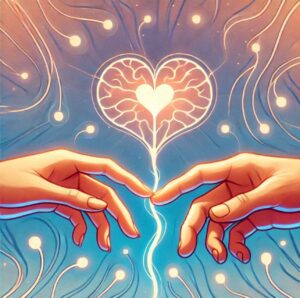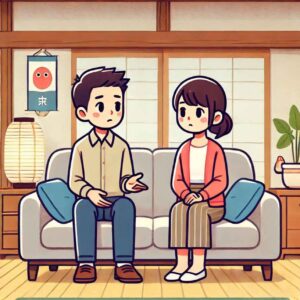Welcome Blessings!
(Tap 🔽 to see more topics!)


The truth about love isn’t always the sweet, simple story we see in movies. We fall in love by chance; we stay by choice. That old saying hints at something more profound than just a spark. We’ve all seen movies and read books where love seems magical and effortless. But by peeling back the layers, it turns out that love is less a fairy tale and more of a fascinating science experiment happening inside our brains. It’s a mix of chemical fireworks, sneaky thought patterns, and hidden instincts that guide us toward certain people and shape our relationships.
Ever catch yourself thinking, “Why them?” or “What went wrong?” It’s like trying to decode a secret language; psychology and neuroscience offer incredible translations. We will explore six key ideas that break down the mysteries of attraction, and some of these truths might surprise you. Forget the roses and violins for a moment, and let’s look at the genuine, sometimes messy, but always compelling science behind why we love.
Have you ever felt an instant, electrifying connection with someone? That’s not magic; it’s your brain on dopamine. Love isn’t just about emotions; it’s a neurochemical cocktail that dictates how we feel and behave in relationships.
It’s no wonder new love feels like an addiction. It hijacks the same reward system as drugs like cocaine! But here’s the catch: as relationships mature, these chemicals balance out, which is why the honeymoon phase eventually fades.
Example: In the movie entitled, The Ugly Truth, Abby initially dismisses Mike’s blunt take on relationships, but as she gets drawn into the emotional highs of attraction, she starts to see the underlying chemistry at play. Their connection, though bumpy, follows the same neurochemical patterns that shape real-life attraction.

You might believe attraction is all about personality, but science suggests otherwise. The Halo Effect is a cognitive bias in which we assume that physically attractive people have other desirable traits, like intelligence, kindness, or success- even if we have no objective evidence.
For example, in an experiment, participants rated identical resumes more favorably when they included an attractive photo. It is why people often say, “They just have that charm,” when it’s our brains associating beauty with positive qualities. While looks aren’t everything, first impressions hold weight in attraction and dating.
Example: Again, in The Ugly Truth, Abby is initially drawn to a handsome doctor because he checks all the boxes of what she believes a perfect man should be. However, as the story unfolds, she realizes that real chemistry and connection go beyond looks and surface-level qualities.

Forget the idea that opposites attract. While differences can add excitement, research shows that long-term relationship success is built on similar values, interests, and communication styles.
It explains why couples who start as friends often have more substantial, enduring relationships. People feel safer and more connected when they find common ground, strengthening bonds over time.
Example: In the same movie, The Ugly Truth, Mike and Abby appear to be complete opposites at first. However, as they spend more time together, they realize they share a similar sense of humor, emotional depth, and values, ultimately fostering their growing connection.
Love doesn’t happen in a single moment; it evolves through stages, each with unique psychological markers.
Many relationships fail to progress past the attraction stage because people mistake infatuation for love. True love happens in the attachment stage, where emotional security replaces the rush of new romance.
Example: In the same movie, Abby and Colin’s relationship fizzles out because it was built on infatuation rather than a deep emotional connection. Meanwhile, her unexpected bond with Mike slowly moves through the stages of attraction into something more tangible and lasting.

Many people assume that arguing means a relationship is failing. But in reality, healthy disagreements are essential for long-term success. The key? How you argue.
Researcher Dr. John Gottman found that couples with a 5:1 ratio of positive to negative interactions are likelier to stay together. In other words, for every argument, there should be five moments of appreciation, laughter, or affection to balance it out.
Example: Mike and Abby’s heated arguments in The Ugly Truth might seem destructive initially, but their back-and-forth helps them confront hidden truths about relationships and themselves. Their ability to challenge each other is what ultimately strengthens their connection.

You can’t pour from an empty cup. The way you see yourself significantly impacts how you love others. People with secure attachment styles with a strong sense of self-worth tend to have healthier relationships.
On the other hand, those with anxious or avoidant attachment styles may struggle with trust, intimacy, or fear of abandonment. If you find yourself stuck in toxic relationship cycles, it might be time to look inward. Your relationship with yourself sets the standard for how others treat you.
Example: Abby starts with insecurities about love, relying on strict dating rules and external validation. As she grows, she realizes real attraction stems from confidence and authenticity rather than trying to fit an ideal mold.
Scarcity creates demand. Studies show that when someone appears less available, we perceive them as more valuable.
Now, this isn’t about being manipulative or playing games. It’s more about understanding that a little bit of mystery and knowing your worth can make you more attractive to others. It’s a human behavior and is not always a conscious effort.

There’s some science behind it. You know how when you’re head-over-heels for someone, they seem perfect? Well, it’s not just you being swept away. It’s your brain.
Love can make you a little less rational. It’s not that you’re stupid; it’s just your brain chemistry doing its thing. It’s like wearing rose-tinted glasses, but they are inside your head.
Do you know that person you always see around, and they grow on you? That’s not just your imagination. It’s a real thing called the “mere exposure effect,” and it’s a big part of the truth about love. We humans are wired to feel more comfortable and attracted to things we’re familiar with.
It’s like that song you didn’t like at first, but after hearing it on the radio a few times, you start humming along. Our brains get used to things, and that familiarity can translate into attraction. It’s a simple but influential part of forming connections with others.
The truth about love isn’t always the picture-perfect image we get from pop culture. We see all this focus on that initial “spark,” the instant attraction. But honestly, that’s just the beginning. It’s like lighting a firework—flashy but quick. What matters in the long run is the warmth that sticks around.
You can be head-over-heels for someone’s appearance, but if you can’t connect on a deeper level, it’s like trying to build a house on sand. You need that solid foundation of emotional intimacy. That’s where the real magic happens, the kind that lasts. It’s about feeling safe, understood, and indeed seen. That’s what turns a fleeting spark into a lasting flame.
Now, we’ve taken a peek behind the curtain. We’ve seen how love isn’t just this fluffy, feel-good thing. It has gears and levers, and a whole science is behind it. And yeah, it can get messy. We’ve all been there – the ups and downs, the “what was I thinking?” moments.
But here’s the good news: understanding how it works? That’s power. It’s like having a map when you’re going through a tricky road. You start to see the twists and turns coming, learn to spot the potholes, and figure out how to build bridges instead of walls.
Knowing that attraction is more than just a random spark? That’s huge. You can be more intentional and a little more aware. You can pay attention to the connections that truly matter, built on fundamental understanding and trust.
And honestly, that’s where the best kind of love lives. It’s not about chasing butterflies but building something solid and real. So, remember what we talked about next time you feel that flutter or wonder why things aren’t clicking. Think about the science, the psychology, and all the little pieces that make up the big picture.
Do you want to explore these ideas and see how they apply to your relationships? Start by reflecting on your own experiences with the ten secrets we discussed. You could even share them with someone close to you; it could spark a fascinating conversation. After all, sharing what you’ve learned is a great way to deepen connection, which, as we know, is the real heart of love. Voila! Until next time!
Additional References:
Paddock, C. 2020, February 14. What does love do to our brains? Medical News Today. https://www.medicalnewstoday.com/articles/what-does-love-do-to-our-brains
Harvard Medical School. 2015. Love and the brain. https://hms.harvard.edu/news-events/publications-archive/brain/love-brain
Oesch, N., & Miklousic, I. 2012. The dating mind: Evolutionary psychology and the emerging science of human courtship. Evolutionary Psychology, 10(5), 899-909. https://doi.org/10.1177/147470491201000511
Luketic, R. (Director). 2009. The Ugly Truth [Film]. Columbia Pictures.